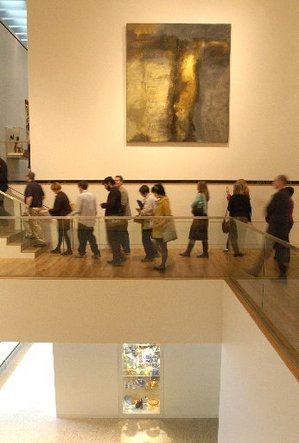A year later, improvements at UMMA lead to higher attendance, new opportunities
When the University of Michigan Museum of Art was working with its National Advisory Board to foresee an improved museum, interim co-director and director of education Ruth Slavin joined in an “envisioning exercise” that had her imagine the museum 1 year after its expansion and renovation. As the new UMMA approaches the 1st anniversary of its reopening, which happened on March 28, 2009, she remembers how the exercise posed the question; “If you were to take the roof off of the UMMA a year later, what would you see?”
The UMMA has more than doubled in size. The new 53,000-square-foot Maxine and Stuart Frankel and the Frankel Family Wing features contemporary architecture designed by Portland-based Brad Cloepfil of Allied Works Architecture, in association with Integrated Design Solutions of Troy. The new wing houses numerous new exhibition and event spaces, including a number of new collection galleries, a special exhibitions gallery, an auditorium, classrooms, study rooms, new conservation facilities, a café and a museum store.

Visitors tour the newly renovated University of Michigan Museum of Art last March.
Beyond its physical improvements, the UMMA’s expansion has also brought new activity and life to the museum. Slavin is pleased to report, “I expect that by the end of this academic year, walk-in visitorship and educational program participation will have doubled.” Since reopening last year, they have had around 240,000 visitors, 626 scholars and students have studied 576 objects in the study rooms, and thousands of people have taken tours of the museum with a docent. About 20,000 people participated in the museum's educational programs in a typical year before the expansion. Slavin predicts that by the end of this academic year, that number will have increased to 35,000-40,000 people.
One of the most significant changes is a large increase in the number of items on display in the museum. Before the expansion, the UMMA could only display about 3% of the over 18,000 artworks and objects that it holds. They can now display around 2,200 artworks and objects in their exhibits on any given day, and an additional 1,200 objects are on view in open storage displays in the museum.
More exhibition space and the option of placing items in open storage “give people access to more examples,” Slavin says. Whereas in the past, the museum might have only had room to display 3 examples of a particular type of object, the UMMA’s new open storage now allows them to display 20 versions of it, she says by way of example. Slavin also adds that open storage is a great place to stick “oddballs,” which “don’t have other collection works to surround them and give them a context.”
More objects on display means that “people can really use the skill of visual comparison. Your brain starts going into this mode and you ask, how are these the same and how are they different? It is like a childhood past time that becomes a fun adult activity,” Slavin says.
Scholars and researchers can “get to the rest” of the UMMA’s thousands of artworks and objects by requesting the use of 2 new study rooms. One is equipped for people to view 2-D works and the other is meant for viewing 3-D objects, Slavin explains. The rooms can be reserved for up to 20 people to view up to 15 items at a time. Booking the study rooms is first come first serve, and priority is given to University of Michigan faculty using the space for their classes.
A new interactive digital learning tool located on the first floor of the new wing, called the DialogTable, allows users to browse the collections and the museum’s themes with a wave of their hand. The next generation learning tool uses gesture recognition software. The DialogTable, along with increased social networking and web communications, is offering museum goers yet another way for people to experience the museum’s collections.
A development that happened along with the expansion is that the UMMA sought to diversify education programming and special events, by formalizing 6 partnerships with local art and music establishments and academic departments within U-M. The museum hosts events, classes and other educational opportunities in collaboration with their formal partners, which include; The Ann Arbor Art Center, The University Musical Society, Ann Arbor Summer Festival; and three U-M departments, including The School of Music, Theater and Dance, the English department’s Zell Creative Writing Series and the department of Screen Arts and Cultures.
In addition to the museum’s formal partners, the UMMA is collaborating with a number of other organizations, businesses and U-M academic departments on events and educational programming. The UMMA is involved in Ann Arbor Film Festival programming this year, and The Ark is presenting a competition for emerging student singer-songwriters. The museum has also collaborated on performances and special events with places like the Ann Arbor District Library and the Hands On Museum in the past, along with others.
Look to the UMMA program calendar and you will see how diverse their highly collaborative lineup of events and educational programming has become.
Overall, Slavin sees the UMMA’s expansion as a great success. She says, “We want it to be a meeting place for the arts” or a “town square” where locals, U-M students and faculty, artists and art-lovers of all ages can experience art, music, film, creative writing and other types of creative expressions.
There are some museum-studies students taking classes over here, and a group of art history student studying with their teacher in a study room over there. Locals and university types alike are enjoying diverse events that give them everything from the classical to the contemporary avant-garde. When she mentally lifts the roof off of the new museum, Slavin sees all different sorts of people accessing art and history in more ways than ever before.
Jennifer Eberbach is a free-lance writer who covers art for AnnArbor.com.

